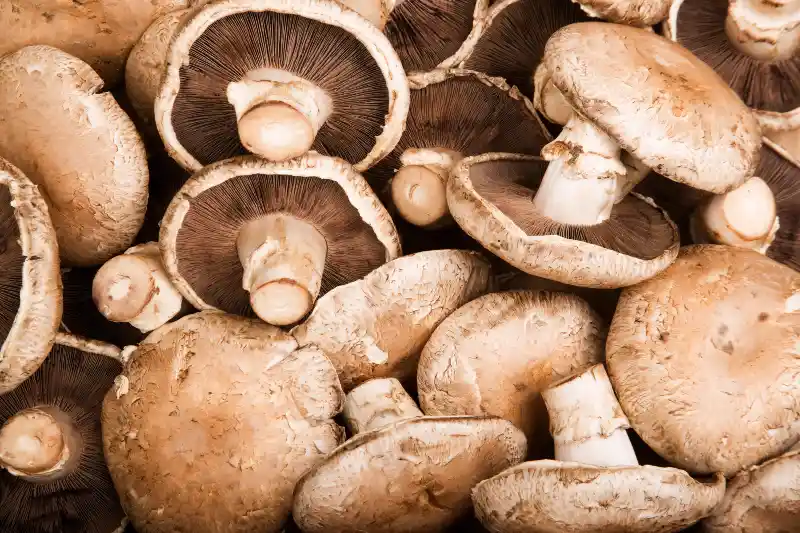Portobello mushrooms, known as Agaricus bisporus, can commonly be found in supermarkets, restaurants, pre-packaged meals, and etc.
Due to their meaty flavor and texture, many mushroom lovers and vegetarians choose them as a meat substitute in different food recipes.
Although they’re nutritious (low in calories and fat, high in fiber, vitamins, and minerals), have many health benefits, and are generally considered safe to eat, you need to be aware of their potential side effects that may arise if you consume too much or you’re sensitive to them.
The public became concerned about the dangers of Portobello mushrooms in 2017 after the mycologist Paul Stamets said agaritines in Portobello mushrooms will lead to health problems if not cooked at a higher temperature.
Here are 8 side effects of Portobello mushrooms:
1. Allergies
Some people may be allergic or sensitive to mushrooms with symptoms like rashes, itching, swelling, respiratory problems, and even severe allergic reactions in extreme cases. If you have experienced these allergies after eating mushrooms, it is advisable to also avoid consuming portobello mushrooms.
2. Digestive Problems
For some people, a high intake of portobello mushrooms can cause digestive issues such as bloating, gas, stomach cramps, or diarrhea, which can be linked to its rich fiber content and specific indigestible compounds like chitin.
If you notice these symptoms after eating portobello mushrooms, you’d better eat less or cook them longer at a higher temperature to break down the chitin.
Meanwhile, portobello mushrooms are high in FODMAPs, which can’t be broken down which can lead to digestive problems, especially for those with sensitive digestive systems or irritable bowel syndrome (IBS).
3. Gout and Kidney Stones
Portobello mushrooms also have a lot of purines. When you eat them, these purines can turn into uric acid, which may accumulate and form crystals in your kidneys. Therefore, eating too many foods with purines, like portobello mushrooms, can increase the chance of getting gout flare-ups or kidney stones.
So if you’ve previously experienced gout or a high uric acid level, you’d better eat fewer portobello mushrooms.
4. Interactions with Medications
Some compounds in Portobello mushrooms can disturb the metabolizing of some medicines. They may block the enzyme that processes certain drugs, altering how the liver deals with these medicines, which affects how the drugs work and increase side effects.
For example, tyramine in Portobello mushrooms, can interact with monoamine oxidase inhibitors (MAOIs), and lead to unwanted reactions.
So if you regularly take medicines, you may need to limit your intake of Portobello mushrooms, and meanwhile, check with your doctor or pharmacist to make sure they don’t interact with portobello mushrooms.
5. Hyperkalemia
Portobello mushrooms have a high potassium content. Most healthy individuals eat Portobello mushrooms as part of a balanced diet is unlikely to cause hyperkalemia, a condition characterized by elevated potassium levels in the blood.
However, the risk is higher for people with kidney disorders, certain medical conditions, or those on specific medications as excessive potassium intake or inability to excrete potassium properly can lead to hyperkalemia.
Consult with a healthcare professional if you have concerns about your potassium intake.
6. Negative Effect On Mineral Absorption
Portobello mushrooms contain oxalic acid, which can combine with calcium and iron to form kidney stones. Meanwhile, these reactions can also reduce the body’s ability to absorb vital minerals like calcium and iron.
Although this impact is usually minor, people with certain mineral deficiencies or those mainly depending on plant sources for these minerals should think about how much of these mushrooms they eat.
7. Not Cook Well May Lead to Cancer
Concerns have risen about the potential negative effects of portobello mushrooms after mushroom expert Paul Stamets discussed them on Joe Rogan’s podcast in 2017.
When discussing Portobello mushrooms, Paul Stamets mentions that there’s a controversial topic surrounding them. He hints at some negative effects associated with Portobellos but doesn’t go into detail during the interview.
Stamets mentions that discussing the topic could put his life in danger, and the interviewer, Joe Rogan, respects his decision not to delve deeper into the subject.
The focus is on the possible carcinogenic property of agaritines, which are present in the portobello mushrooms.
Paul said, “Portabellos have a problem. All mushrooms should be cooked, and portabellos, in particular, should be cooked at high temperatures.”
Agaritines are a type of hydrazine that breaks down with heat. So, you need to cook the mushrooms thoroughly to eliminate them. If they’re well-cooked, they wouldn’t pose an issue. However, if not cooked properly, these hydrazines could be concerning.
8. Heavy Metal Toxicity
Portobello mushrooms can absorb and accumulate heavy metals such as mercury from the ground. So if you eat them in large amounts every day, it may do bad to your health.
How to Reduce the Negative Effects Of Portobello Mushrooms
Here are some tips you can follow to reduce the negative effects of Portobello mushrooms.
1. Purchase from Reliable Providers
Portobello mushrooms are the grown-up form of several brown strains of the species. In nature, harmful mushrooms can resemble Portobello mushrooms.
Therefore, harvesting wild mushrooms without proper knowledge can result in severe poisoning or even death. It’s safer to buy them from trusted sellers or cultivate them in controlled conditions.
2. Buy Fresh Portobello Mushrooms
Always prioritize purchasing the freshest Portobello mushrooms available. Fresh mushrooms have a firm texture, a pleasant earthy aroma, and are free from any dark spots or sliminess.
Older mushrooms not only lose their nutritional value but can also harbor harmful bacteria and fungi. Therefore, always check the harvest date, if available, and inspect the mushrooms thoroughly before buying.
3. Store Properly
Mushrooms, including Portobellos, should be stored in a cool, dry place, preferably in the refrigerator. If you don’t eat them on the same day you buy, you can place whole, unwashed mushrooms in a brown paper bag and fold the top of the bag over, which can help absorb excess moisture and prevent them from becoming slimy or moldy.
Then store the bag in the main compartment of your refrigerator. If you don’t have a brown paper bag, you can wrap the mushrooms in a paper towel and place them in a bowl in the refrigerator.
4. Check for Signs of Spoilage
Before cooking or consuming, always check your mushrooms for any signs of spoilage such as a sour smell, sliminess, or dark spots. Consuming spoiled mushrooms can lead to food poisoning.
5. Proper Handle Before Eating
Ensuring that Portobello mushrooms are handled correctly before consumption is crucial to minimize potential side effects. Here are some steps to follow:
Clean Appropriately
The unique structure of Portobello mushrooms, especially the gills beneath the cap, can trap dirt, bacteria, and other contaminants. To ensure they are safe for consumption:
- Avoid soaking them in water as they can become soggy. Instead, use a damp cloth or a soft brush to wipe off any visible dirt.
- If you choose to rinse them, do so briefly under cold running water and pat them dry immediately.
- Pay special attention to the gills. As these are the areas where spores are dispersed, they can have numerous hiding places for contaminants. Gently brush or wash out any debris from the gills to minimize bacterial or fungal contamination, as well as any potential pesticide residues or pollutants.
Completely Cook Before Consumption
As said before, raw mushrooms contain naturally occurring agaritines, which may lead to cancer, but can be broken down through cooking. Therefore, it’s essential to:
- Cook Portobello mushrooms thoroughly at a higher temperature before eating. This not only destroys heat-sensitive substances, and kills bacteria/microbes, but also enhances their flavor and nutritional value.
- Use methods like grilling, baking, sautéing, or roasting to ensure they are cooked evenly.
- Avoid consuming raw Portobello mushrooms, especially in large quantities, to prevent potential side effects.
5. Be Aware of Allergies and Sensitivities
Some individuals may have allergies or sensitivities to certain compounds found in Portobello mushrooms. Before consuming them for the first time, you’d better eat a small amount to check for any adverse reactions. If you experience itching, swelling, or any other allergic symptoms, it’s best to avoid them.
6. Avoid Overconsumption
While Portobello mushrooms are nutritious and delicious, if you eat them in large quantities may lead to digestive issues for some people. Therefore you need to consume them in moderation.
7. Be Cautious with Medications
As mentioned above, mushrooms can interact with certain medications, so if you’re on any medication, especially antibiotics or antifungals, consult with your doctor or pharmacist before consuming Portobello mushrooms.
8. Consult with a Healthcare Provider
If you have specific health concerns or conditions that may be affected by consuming mushrooms, it’s recommended to consult with your healthcare provider. They can provide guidance tailored to your individual needs.
By following these guidelines, you can enjoy the delicious taste and health benefits of Portobello mushrooms while minimizing any potential risks.
Conclusion
Portobello mushrooms are generally safe to consume. However, you’d better be aware of their possible side effects as that may happen to you.






